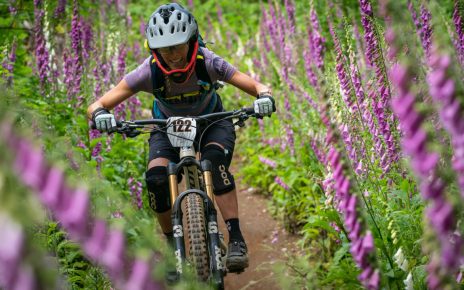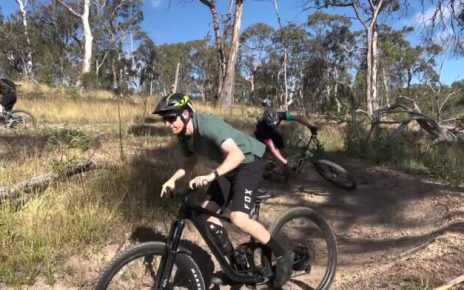Although you might not have been aware of it, urban downhill mountain bike racing has been wowing crowds for years. The gravity discipline is held on an array of wild courses across Europe and South America, and the sport going strong in 2020.
Unsure what urban downhill is? Expect high speeds, narrow courses, lots of steps, massive jumps, thousands of spectators and quite possibly a stray dog on the track. If this has piqued your interest, read on to find out more…
What is urban downhill?
Urban DH is raced in the same format as a Mercedes Benz UCI Downhill World Cup: competitors ride individually and are timed from start to finish, with the fastest time winning the race. There is usually a small amount of practise allowed on the course, followed by one qualifying run and one race run.
The sport took off in the early 2000s with the Red Bull Lisbon Downtown race that sped through the tight alleyways and stair sets of the Portuguese capital. This started a craze, and a great number of urban races and even an entire race series sprung up across the world. While there are still plenty of events in Europe, the best-known urban races are those in South America, including Red Bull Monserrate Cerro Abajo and Red Bull Valparaíso Cerro Abajo (the latter of which isn’t running in 2020) – truly spectacular races that attract global coverage.
Course are mostly through closed streets and down flights of steps, but sometimes organisers throw in sections of off-road through parks and at the bigger events there will usually be man-made jumps, wall rides and drop-offs. Courses are sometimes made even more thrilling by sending riders off rooftops, down tight alleyways and even through buildings.
When is the urban downhill season?
Urban racing in South America takes place during what is the off-season for Downhill World Cup and Enduro World Series racers. This means the continent’s summer is in full swing and the timing allows some of the best mountain bikers from all disciplines to try their hand at what is much more than a show event – urban downhill is serious business and can draw some of the biggest crowds of any mountain bike race. The 2020 urban downhill season kicked off in Manizales, Colombia, in January and was won by Czech Republic’s Tomáš Slavík.
European races take place from March onwards, with events happening across the continent. In 2020 there are events planned in France, Italy, Spain and even Scotland. European urban mountain bike races perhaps aren’t as spectacular as their South American counterparts, but they still garner a lot of attention from the public and occasionally take on unique formats with races through shopping malls or a dual slalom in town centres.
Who are the best urban downhill athletes?
With races taking place right in the heart of cities in front of thousands of vying spectators, it is no surprise that the world’s best downhill and enduro racers are attracted to urban downhill races, particularly those in South America.
Viral GoPro footage of flat-out runs on courses that literally pass through houses also helps. Little wonder the videos go viral: who wouldn’t want to ride on-board from the safety of a sofa as their mountain bike heroes throw themselves at some of the most daunting tracks of the year while dodging stray dogs and avoiding over-excited onlookers?
Many top downhillers have raced in the big events in South America, including Filip Polc, Brook MacDonald, Wyn Masters, Marcelo Gutierrez, Johannes Fischbach and Tomáš Slavík. But many events are open to all (some requiring pre-qualification), and the South American races showcase talented athletes that aren’t often seen on the global circuit – Chile’s Pedro Ferreira won the 2019 Red Bull Valparaiso Cerro Abajo in front of a stacked field.
What bikes are used for urban downhill?
The field use a mix of downhill-specific and enduro bikes
© Alfred Jürgen Westermeyer/Red Bull Content Pool
With races hurtling at breakneck speed down ridiculously technical courses with hucks from rooftops and out of windows (really), a sturdy bike is needed for street racing.
In the past, this meant downhill bikes only – the triple-clamp forks, 200mm suspension travel, strong wheels and big disc brakes were the only available bikes that could stand up to the punishment. But modern enduro bikes, as raced in the Enduro World Series, are robust and incredibly capable, plus they work well for the flat sprints that often link sections of a course. Nowadays, you’ll find a mix of downhill and enduro bikes on the urban DH scene.
Suspension is set up firm in order to take the hits of bigger jumps, for ease of sprinting and to keep the bike stable when hitting stair gaps at speed. Riders might opt for custom modifications such as specific suspension tunes, low-profile rear tyres, narrower handlebars, higher front ends and might remove the dropper seat post on enduro bikes. All these changes aim to make the bike stable down stair sets, nimble and easy to sprint.
What is the biggest urban downhill race of the year?
The Red Bull Monserrate Cerro Abajo race takes place in Colombia on February 22 2020 and promises to be one of the most exciting ever urban downhill races. Competitors will be faced with a monstrous course descending more than a thousand steps along its 2.4km length – in fact, the course is so long that it has an official Guinness World Record as the longest urban downhill track in the world.







